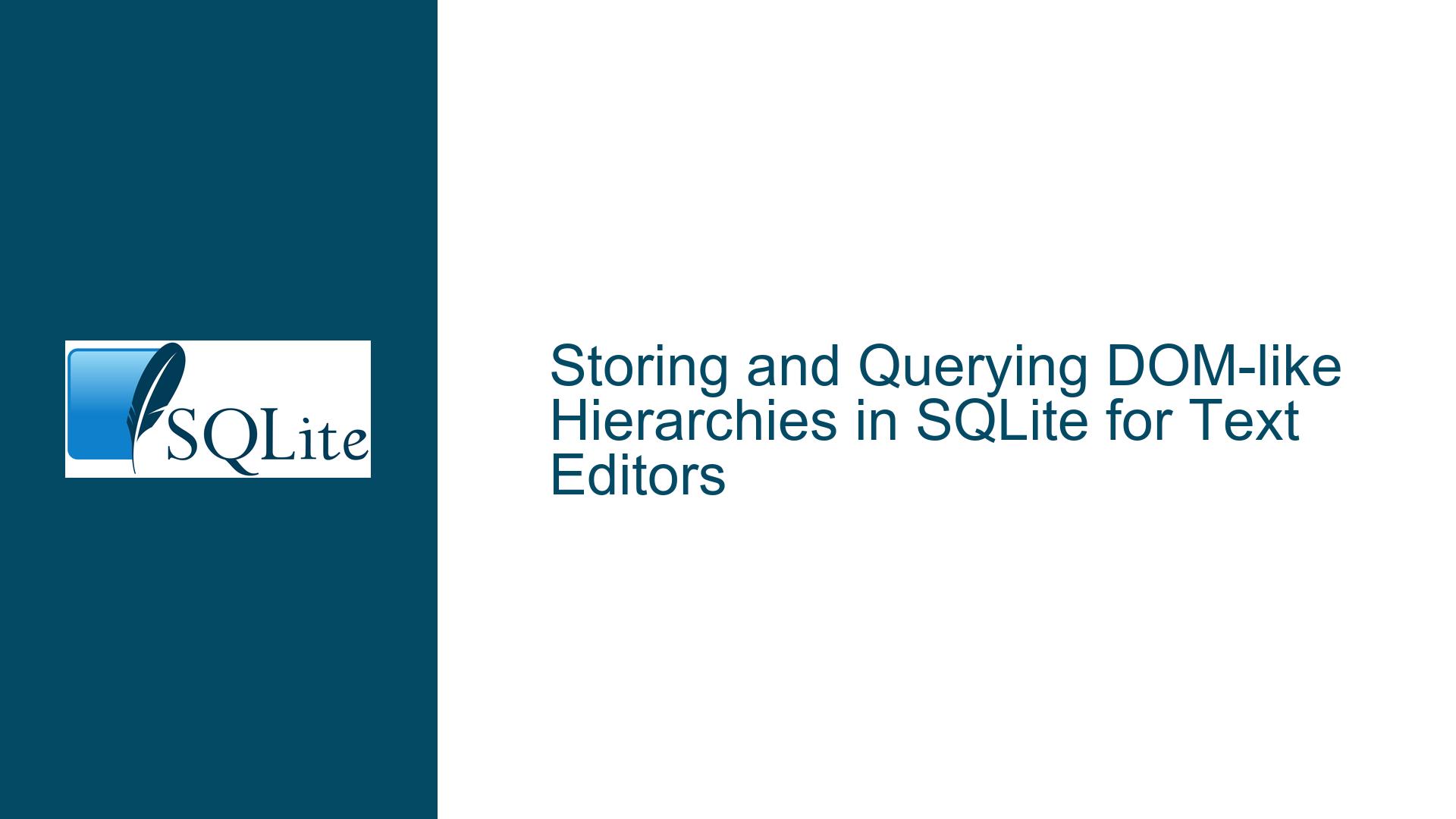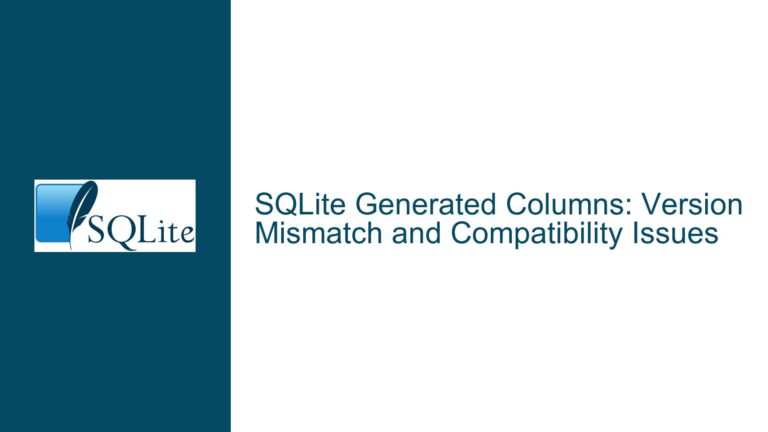Storing and Querying DOM-like Hierarchies in SQLite for Text Editors
Hierarchical DOM Representation Challenges in Relational Databases
The core issue revolves around modeling a Document Object Model (DOM)—a hierarchical tree structure—within SQLite’s relational framework to support operations typical of a text editor. A DOM requires efficient traversal, insertion, deletion, and modification of nodes, which are inherently hierarchical (parent-child relationships, nested elements). SQLite, while flexible, is not optimized for hierarchical data natively. Relational databases excel at flat, tabular data, but hierarchical structures demand recursive navigation and maintenance of tree integrity. For instance, a text editor’s DOM might involve paragraphs, sentences, words, and formatting tags, all nested within one another. Storing this in a relational schema requires careful design to avoid performance bottlenecks during frequent updates or complex traversals.
A DOM tree’s hierarchical nature conflicts with SQLite’s row-based storage. Each node (e.g., a text element or formatting tag) must reference its parent, and subtree operations (e.g., reordering sections) require updating multiple rows. Consider a simple schema using an adjacency list model: a table with node_id, parent_id, and content. While this captures parent-child relationships, querying an entire subtree necessitates recursive queries or multiple joins. SQLite’s recursive Common Table Expressions (CTEs) can traverse such structures, but they are computationally expensive for deep trees. For example, rendering a chapter in a text editor might require traversing hundreds of nodes, each representing paragraphs, sentences, or inline styles. This introduces latency, especially if the tree is modified frequently.
Another challenge is maintaining referential integrity. Deleting a parent node should cascade to its children, but SQLite’s foreign key constraints require explicit configuration. Without proper indexing, operations like finding all descendants of a node degrade into full table scans. Additionally, text editors demand atomic transactions for undo/redo functionality. SQLite supports transactions, but frequent commits to reflect real-time edits can lead to contention or lock escalation. These factors make it critical to evaluate whether SQLite’s relational model aligns with the DOM’s hierarchical and transactional requirements.
Performance Limitations in Real-Time Text Editing Scenarios
Text editors require low-latency interactions, which amplifies the impact of suboptimal database design. Consider a scenario where a user inserts a character into a document. This action might involve updating a text node, recalculating positional metadata (e.g., line numbers), and propagating changes to parent nodes (e.g., paragraph length). If the DOM is stored in SQLite using an adjacency list, each update could trigger multiple queries: fetching the node’s parent, updating its metadata, and potentially updating sibling nodes. These operations, when repeated thousands of times per minute in a collaborative editor, strain SQLite’s transaction throughput.
Concurrency is another concern. SQLite uses a write-ahead log (WAL) to allow concurrent reads and writes, but write transactions are still serialized. In a multi-user editor, simultaneous edits to different branches of the DOM could block each other, leading to lag. For example, User A editing a footnote while User B modifies a header might experience contention if their transactions affect overlapping parts of the tree. While SQLite’s WAL mode mitigates this, it does not eliminate the bottleneck entirely. This is exacerbated in editors requiring frequent auto-saves or real-time collaboration features.
Storage overhead also plays a role. A DOM with thousands of nodes (e.g., a large document with intricate formatting) stored via adjacency lists or nested sets consumes significant space for metadata (parent IDs, depth levels). The JSON1 extension offers an alternative by storing the entire DOM as a JSON string, enabling partial updates via json_set or json_insert. However, JSON parsing introduces CPU overhead, and large JSON blobs become unwieldy. For instance, querying a single node within a 10MB JSON document requires parsing the entire structure, which is impractical for real-time rendering.
Strategies for Efficient DOM Storage and Querying Using SQLite Features
To balance hierarchy and performance, hybrid models combine relational and hierarchical paradigms. One approach is the closure table pattern, which stores all ancestor-descendant relationships explicitly. A node_closure table with ancestor_id, descendant_id, and depth columns allows efficient subtree queries. For example, fetching all descendants of a chapter node becomes a single lookup. While this denormalizes data, it optimizes read-heavy workflows like rendering. Maintenance triggers can update the closure table on node insertions/deletions, ensuring consistency. SQLite’s trigger support enables this, though triggers add write overhead.
Another strategy leverages SQLite’s JSON1 extension for hierarchical storage. Storing the DOM as a JSON tree in a single column allows using JSONPath queries for traversal. For example, json_tree(document, '$.sections[*].paragraphs') extracts all paragraphs. However, partial updates are limited; modifying a single node requires rewriting the entire JSON blob. To mitigate this, segment the DOM into smaller JSON fragments (e.g., per chapter) stored in separate rows. This allows targeted updates but complicates cross-fragment queries. Combining JSON storage with a searchable metadata table (e.g., node IDs, types, and parent references) offers a balance.
For write-heavy editors, materialized path encoding optimizes node positioning. Each node stores its path as a string (e.g., /1/3/2, representing the node’s position in the hierarchy). The GLOB operator can query descendants: WHERE path GLOB '/1/3/*'. Indexing the path column accelerates these queries. However, path updates (e.g., moving a subtree) require recalculating paths for all affected nodes, which is expensive. SQLite’s UPDATE FROM syntax with joins can streamline this, but it remains a trade-off between read and write efficiency.
Finally, caching layers reduce database load. SQLite’s in-memory databases or application-side caches store frequently accessed subtrees. For instance, the currently open chapter in a text editor could reside in memory, with changes batched to disk periodically. This approach leverages SQLite’s durability while minimizing I/O. However, it introduces complexity in cache invalidation and crash recovery.
In conclusion, while SQLite can store DOM-like hierarchies, success depends on schema design tailored to specific access patterns. For read-heavy editors, closure tables or JSON segmentation work well. Write-heavy scenarios benefit from adjacency lists with triggers or materialized paths. Combining these with SQLite’s extensibility (e.g., JSON1, triggers) and concurrency features (WAL mode) creates a robust foundation for hierarchical text editing.






